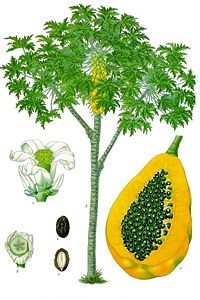Papaya: Difference between revisions
Jump to navigation
Jump to search

imported>Todd Coles (remove WP categories) |
imported>Minhaj Ahmed Khan Lodi (re-writing from scratch) |
||
| Line 18: | Line 18: | ||
}} | }} | ||
The '''papaya''' | The '''papaya''' is the [[fruit]] of the [[plant]] ''Carica papaya'', in the genus ''[[Carica]]''. | ||
Latest revision as of 10:39, 15 March 2008
- The content on this page originated on Wikipedia and is yet to be significantly improved. Contributors are invited to replace and add material to make this an original article.
| Papaya | ||||||||||||||
|---|---|---|---|---|---|---|---|---|---|---|---|---|---|---|
 Papaya tree and fruit, from Koehler's Medicinal-Plants (1887)
| ||||||||||||||
| Scientific classification | ||||||||||||||
| ||||||||||||||
| Binomial name | ||||||||||||||
| Carica papaya L. |
The papaya is the fruit of the plant Carica papaya, in the genus Carica.